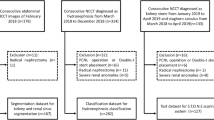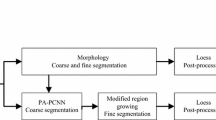Abstract
This paper proposes a detection scheme for identifying stones in the biliary tract of the body, which is examined using magnetic resonance cholangiopancreatography (MRCP), a sequence of magnetic resonance imaging targeted at the pancreatobiliary region of the abdomen. The scheme enhances the raw 2D thick slab MRCP images and extracts the biliary structure in the images using a segment-based region-growing approach. Detection of stones is scoped within this extracted structure, by highlighting possible stones. A trained feedforward artificial neural network uses selected features of size and average segment intensity as its input to detect possible stones in MRCP images and eliminate false stone-like objects. The proposed scheme achieved satisfactory results in tests of clinical MRCP thick slab images, indicating potential for implementation in computer-aided diagnosis systems for the liver.








Similar content being viewed by others
References
ACR/NEMA (1993) Standards Publication PS3/DICOM 3 (Digital Imaging and Communications in Medicine Standard)
CSU (2001) Secretion of bile and the role of bile acids in digestion, http://www.arbl.cvmbs.colostate.edu/hbooks/pathphys/digestion/liver/bile.html [accessed 31 December 2005]
Doi K, MacMahon H, Giger ML, Hoffmann KR (eds) (1999) Computer-aided diagnosis in medical imaging. Elservier, Amsterdam
Fisher B, Perkins S, Walker A, Wolfart E (1994) HyperMedia image processing reference. Department of Artificial Intelligence, The University of Edinburgh. http://www.cee.hw.ac.uk/hipr/html/gsmooth.html [accessed 17 May 2006]
Guibaud L, Bret PM, Reinhold C, Atri M, Barkun AN (1994) Diagnosis of choledocholithiasis value of MR cholangiography. AJR 163(4):847–850
Lee MG, Jeong YK, Kim MH, Lee SG, Kang EM, Chien D, Shin YM, Ha HK, Kim PN, Auh YH (1998) MR cholangiopancreatography of pancreaticobiliary diseases, comparing single-shot RARE and multislice HASTE sequences. AJR 171:1539–1545
Lo P, Bister M, Eswaran C (2004) Watershed segmentation with gradient threshold and root merging for ultrasound images. In: Proceedings of the South-East Asian congress of medical physics (SEACOMP) & Asian-Oceania congress of medical physics (AOCMP), Kuala Lumpur, Malaysia, pp 251–256
Logeswaran R (2005) Scale-space segment growing for hierarchical detection of biliary tree structure. Int J Wavelets Multiresolut Inf Process 3(1):125–140
Logeswaran R, Eswaran C (2005) Application of 3D multiresolution analysis for structure detection in 2D. Multimed Cyberscape J 3(4):30–34
Robinson K, Whelan PF (2005) Analysis of the pancreato-biliary system from MRCP. Computer-based medical systems, pp 253–258
Robinson K (2005) Efficient pre-segmentation. PhD thesis, Dublin. http://www.eeng.dcu.ie/∼robinsok/pdfs/Robinson_PhDThesis2005.pdf
Sarle WS (ed) (2004) Neural network FAQ, part 3 of 7: generalization (What are cross-validation and bootstrapping?), periodic posting to the Usenet newsgroup comp.ai.neural-nets. http://www.ftp://ftp.sas.com/pub/neural/FAQ.html
Szolovits P, Patil RS, Schwartz WB (1998) Artificial intelligence in medical diagnosis. Ann Intern Med 108(1):80–87
Tzanakou EM (2000) Supervised and unsupervised pattern recognition (feature extraction and computational intelligence). Industrial electronics series. CRC press, Boca Raton
Vincent L, Soille P (1991) Watersheds in digital spaces: an efficient algorithm based on immersion simulations. Trans Pattern Anal Mach Intel 13:583–598
Acknowledgment
The author would like to express his gratitude to the consulting specialist, Dr. Zaharah Musa from Selayang Hospital, Malaysia for the expert medical consultation and MRCP patient images used in this work. This work was supported by the Ministry of Science, Technology and Innovation, Malaysia, through the Intensification for Research in Priority Areas (IRPA) grant scheme.
Author information
Authors and Affiliations
Corresponding author
Rights and permissions
About this article
Cite this article
Logeswaran, R. Neural networks aided stone detection in thick slab MRCP images. Med Bio Eng Comput 44, 711–719 (2006). https://doi.org/10.1007/s11517-006-0083-8
Received:
Accepted:
Published:
Issue Date:
DOI: https://doi.org/10.1007/s11517-006-0083-8




